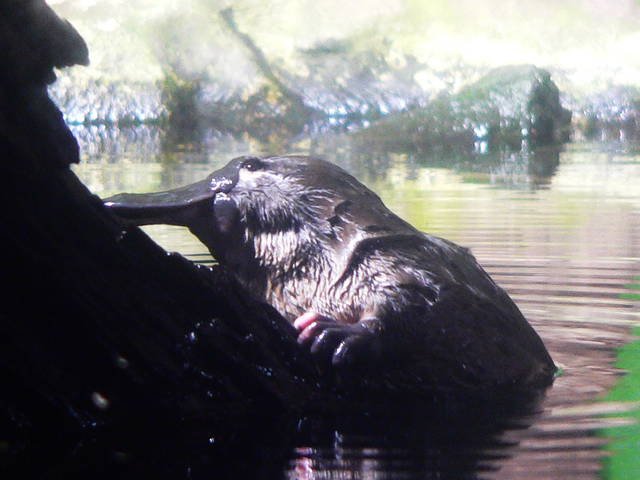Published in the Ocean Watch column, Honolulu Star-Advertiser © Susan Scott
May 20, 2017
GREAT KEPPEL ISLAND, QUEENSLAND, AUSTRALIA >> “It’s so small.” That was our group’s first impression of the platypus we saw paddling along the surface of a creek in Carnarvon National Park. When an animal is as celebrated as the platypus, people expect something bigger than a chihuahua.
The weather had continued its stormy streak, making sailing Honu unappealing. But in Australia, to-die-for wildlife is always close by. We rented a car, drove to the national park and were soon hiking with kangaroos and wallabies, laughing with kookaburras and cockatoos, and gasping at a sugar glider’s aerial show. And even though they aren’t marine, three platypuses kindly showed up to give us an aquatic thrill.
 A platypus, a mammal of rather ordinary stature with a ducklike bill,
A platypus, a mammal of rather ordinary stature with a ducklike bill,
is seen at a national park in Queensland, Australia.
©2017 Susan Scott
Platypuses are freshwater animals that spend their days snoozing in riverside burrows. At dusk the creatures emerge to forage for insects, shrimp, tadpoles, mussels and snails in the streambed. In zoos, keepers often feed their platypuses yabbies, which I now know are freshwater crayfish.
Platypuses have been famous in biology lore since 1799 when an official in Australia sent a hide of the animal to Great Britain.
Scientists there thought that some jokester had sewn a duck bill to a beaver body.
The platypus bill so resembles a duck’s bill that a common name for the animal is duck-billed platypus, even though no other platypus species exits.
Nor is the bill a bill. It’s a single, flat leathery organ containing nerves that detect electrical fields generated by living prey. Sharks and electric eels also use electroreception to find food, but the platypus is one of the only mammals with that ability.
Speaking of mammals, that’s another platypus claim to fame. These little 4- to 6-pound creatures lay eggs and then nurse their hatchlings.
After mating, the female produces two eggs, which she incubates inside her body for about 28 days. Once laid, the mother curls her tail, a fat storage structure, around the eggs for another 10 days. Hatched platypus babies suck milk from two mammary patches (no nipples) on their mother’s belly.
Upon returning to Honu from our adventure inland, the wind lay down, the sun shone brightly and off we sailed to the Keppel Islands, popular anchorages in the Great Barrier Reef Marine Park. On the voyage another nonmarine species awed us all day long. Streams of exquisite blue-and-brown butterflies called blue tigers passed through Honu’s rigging while migrating from the mainland to the islands of the Great Barrier Reef.
As I write, it’s pouring rain again, but who cares? I’m in Australia.